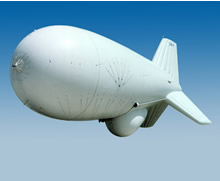 Joint Land Attack Cruise Missile Defense Elevated Netted Sensors System (JLENS) utilizes a tethered early warning and surveillance sensor installed in an aerostat, positioned at medium altitude. Such system provides over-the-horizon detection and tracking of aircraft, helicopters, UAVs and primarily – the most illusive cruise missiles. JLENS will be positioned at an altitude of up to 15,000 feet for extended periods, to elevate radar, ESM and communication systems and networking assets which will offer wide-area surveillance and tracking of land attack cruise missiles. Such targets may go undetected by surface-based sensors because of terrain masking and line-of-sight locations of targets. Other sensors on board will also detect and tracking of surface moving targets. The system will effectively cover and track targets over 360-degree, providing an integrated air picture via multiple sensors and command, control, communications and intelligence (C3I) networks. The sensor suite consists of a surveillance radar (SR) and a precision track and illumination radar (PTIR). The SR provides a long-range air picture enhanced by identification friend or foe. The PTIR is a steerable, lightweight array capable of tracking multiple targets in a sector. The JLENS prioritizes remote and local tracks autonomously or accepts external requests for precision tracking and engagement support. An elevated sensor such as JLENS can support ground based air defense units, such as Patriot, Aegis/Standard Missile and SLAMRAAM. The large area coverage and multiple target tracking capability enable such system to support both surface-to-air and air-to-air missile engagements, by relaying updated intercept solutions to airborne missiles or via their launchers, in engage-on-remote and forward pass operating modes. In late November 2003, the Army announced its intention to redeploy the Rapid Aerostat Initial Deployment (RAID) force protection aerostat from Afghanistan to Iraq. A different concept of an untethered airship is pursued by Lockheed Martin. The program cost is estimated at US $149 million with completion expected by November 2010.
Joint Land Attack Cruise Missile Defense Elevated Netted Sensors System (JLENS) utilizes a tethered early warning and surveillance sensor installed in an aerostat, positioned at medium altitude. Such system provides over-the-horizon detection and tracking of aircraft, helicopters, UAVs and primarily – the most illusive cruise missiles. JLENS will be positioned at an altitude of up to 15,000 feet for extended periods, to elevate radar, ESM and communication systems and networking assets which will offer wide-area surveillance and tracking of land attack cruise missiles. Such targets may go undetected by surface-based sensors because of terrain masking and line-of-sight locations of targets. Other sensors on board will also detect and tracking of surface moving targets. The system will effectively cover and track targets over 360-degree, providing an integrated air picture via multiple sensors and command, control, communications and intelligence (C3I) networks. The sensor suite consists of a surveillance radar (SR) and a precision track and illumination radar (PTIR). The SR provides a long-range air picture enhanced by identification friend or foe. The PTIR is a steerable, lightweight array capable of tracking multiple targets in a sector. The JLENS prioritizes remote and local tracks autonomously or accepts external requests for precision tracking and engagement support. An elevated sensor such as JLENS can support ground based air defense units, such as Patriot, Aegis/Standard Missile and SLAMRAAM. The large area coverage and multiple target tracking capability enable such system to support both surface-to-air and air-to-air missile engagements, by relaying updated intercept solutions to airborne missiles or via their launchers, in engage-on-remote and forward pass operating modes. In late November 2003, the Army announced its intention to redeploy the Rapid Aerostat Initial Deployment (RAID) force protection aerostat from Afghanistan to Iraq. A different concept of an untethered airship is pursued by Lockheed Martin. The program cost is estimated at US $149 million with completion expected by November 2010.
Home Regional News North America Joint Land Attack Cruise Missile Defense Elevated Netted Sensor System
















